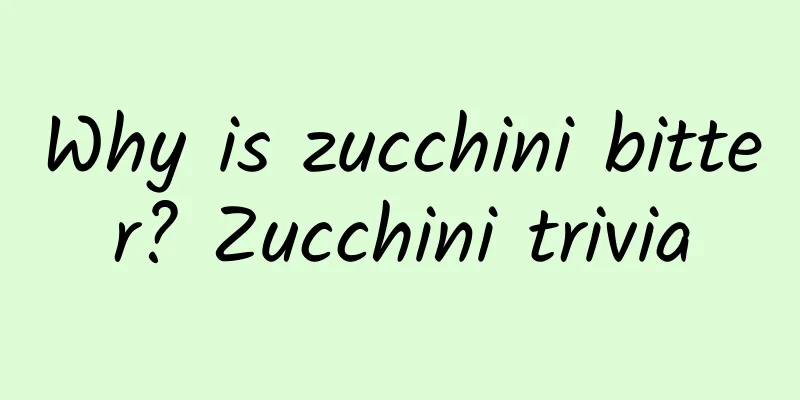Why is zucchini bitter? Zucchini trivia

|
In our daily life, we often eat zucchini, but we don’t pay much attention to it or know much about it. Today, Encyclopedia Knowledge Network will show you some little knowledge about zucchini, and also let us know why zucchini is sometimes bitter. Are you still a little interested? O(∩_∩)O Contents of this article 1. Zucchini knowledge 2. Why is zucchini bitter? 3. The difference between winter squash and zucchini 1Zucchini TipsCucurbita pepo L. is an annual vine herb; the stem has ridges and grooves. The petiole is sturdy and covered with short bristles; the leaves are hard, upright, triangular, curved and semicircular, dark green above, lighter in color below, and with rough hairs on both sides of the veins. The tendrils are slightly sturdy. Monoecious. The male flowers are solitary; the pedicels are sturdy, angular, and covered with yellow-brown short bristles; the calyx lobes are linear-lanceolate; the corolla is yellow with a sharp tip; the stamen filaments are 15 mm long, and the anthers are close together. The female flowers are solitary, and the ovary is ovate. The fruit pedicels are sturdy and have obvious ridges and grooves, and the fruit pedicels become thicker or slightly enlarged. The shape of the fruit varies depending on the variety; the seeds are ovate, white, about 20 mm long, with arched and blunt edges. Originated in southern North America, China began to introduce it from Europe for cultivation in the mid-19th century, and it is now distributed all over the world. Zucchini contains a lot of nutrients such as vitamin C and glucose, and has the benefits of relieving restlessness and thirst, moistening the lungs and relieving coughs, clearing away heat and promoting urination, and reducing swelling and dispersing nodules. The fruit is used as a vegetable. 2Why is zucchini bitter?1. Zucchini tastes bitter because it contains a substance called "bitterness". This is related to the vegetable farmers' choice of vegetable seed varieties. Some zucchini seeds have a high content of bitterness, so the fruits grown naturally taste bitter. 2. Zucchini encounters some problems in planting and management, which causes the fruit to become bitter. For example, in hot and dry weather, the absorption function of the root system is weakened, and more bitter substances will accumulate; or it may be due to excessive nitrogen fertilizer application. If only nitrogen fertilizer is used, nitrogen nutrition will be excessive, which will also easily increase the concentration of bitter substances in zucchini. Currently, it is impossible to tell the difference with the naked eye except by using professional instruments or tasting it yourself. However, the bitter zucchini itself does not contain any toxins. On the contrary, certain bitter substances contained in vegetables are beneficial to human health and can be used with confidence. 3Differences between Winter Squash and ZucchiniWinter Squash First of all, winter squash, also known as Indian pumpkin, jade squash, and northern squash, belongs to the Cucurbitaceae family and the genus Cucurbita, and is an annual vine herb. Artificial cultivation of winter squash is mainly for the purpose of obtaining tender squash and seeds. In terms of appearance, the stem of winter squash is nearly round. The leaves are soft and hairy, round or heart-shaped, with very shallow or no cracks, and no white spots. The corolla lobes are soft and droop outward, the sepals are narrow and long, and the buds are truncated at the opening tip. The fruit pedicel is short and cylindrical, and the base is not swollen. The fruit surface is smooth, the ripe fruit has no aroma, and the sugar content is low. squash Zucchini is also known as bear (male) melon, wild rice melon, white melon, small melon, pumpkin, horned melon, and vine. It is an annual herbaceous vine (climbing). It is native to India and is planted in both southern and northern China. There are three major strains: dwarf, semi-climbing, and climbing. Most varieties of zucchini have a dominant main vine, with few and weak side vines. The stem of zucchini has ridges and grooves, short bristles and translucent rough hairs. The petiole is thick, covered with short bristles, and is 6-9 cm long. It likes moisture and is not drought-resistant. Especially during the melon-bearing period, the soil should be kept moist to obtain high yields. Therefore, the most direct way to distinguish the two is to look at the pedicel, which is the stem. The pedicel of winter squash is cylindrical, without ridges on the surface, and the part in contact with the fruit is not significantly enlarged. The pedicel of zucchini has obvious ridges on the surface, but the part in contact with the fruit is not significantly enlarged, at most it is slightly thickened. |
>>: Why can't patients with hypertension have their teeth extracted easily?
Recommend
Brown period after 8 days
The menstrual cycle is different for different pe...
What are the routine tests for vaginal discharge?
In fact, women’s secretions can reveal many probl...
Exercise prescription for people who sit in the office for a long time
Author: Wei Hongyan Affiliated Hospital of Southw...
What happens if there is a serious lump in the breast?
Don’t underestimate the phenomenon of breast lump...
The harm of taking linolenic acid for pregnant women
There are many reasons for the discomfort in the ...
What is a hernia? Does it require surgery?
What is hernia? Generally speaking, hernia is a s...
What should I do if my menstruation suddenly stops?
The menstruation has always been normal but sudde...
Introduction to ovarian lymphoma
What is ovarian lymphoma? Both the elderly and ch...
How to prevent postpartum breathing problems
Some women experience difficulty breathing after ...
What causes uterine pain in pregnant women?
After a pregnant woman becomes pregnant, she beco...
What are the symptoms of breast cancer?
Many female friends want to have a beautiful figu...
Is gynecological fungal infection serious?
Women's body immunity is poor, and the incide...
What impact will poor follicular development have on pregnancy?
I believe everyone knows about the process of con...
Is it more nutritious to drink milk in the morning?
Myth: Drinking milk in the morning is easier to a...









